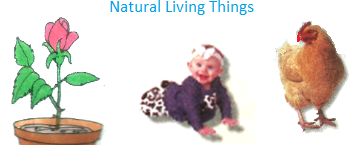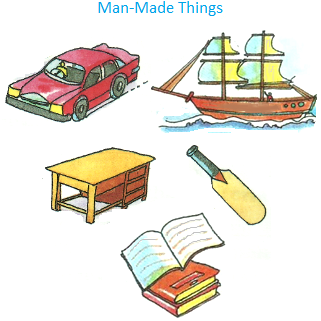Living and Non-Living Things
We see many living and non-living things around us. We see men, women, children, animals, plants, birds, insects, bicycles, houses, stones, roads, benches, the Sun, the moon, the stars, mountains, water, etc. These things can be divided in different categories. Some of them are living things and the others are non-living things. Some of them are natural while others are made by humans called man-made things.
The world is made up of beautiful things. It has many types of plants and animals. We can see rivers, springs, valleys of flowers, and large mountains. At cold places, mountains are covered with snow. There are forests where we find wild animals and plants. We enjoy snowfall and play in rain. We swim and play with water. We also love singing of birds and to play with animals. All things in the world can be categorized as living things and non-living.
Natural Things:
Nature provided us many things including living and as well as non-living things. Plants, animals, birds, fish and human beings are natural things.
Certain non-living things like mountains, rivers, clouds, rain are also natural. These things are the gifts of nature. Remember, we cannot make these things ourselves.
Man made things:
There are many things which are made by man. They are called man-made things. Man has made things to satisfy his needs.
Man needs shelter, so he makes homes. Man also needs clothes, furniture, paper, books and much more.
Man needs transport to move. So he makes cars, buses, trains, ships, airplanes.
Man has made all these from natural things.
Living things and non-living things:
We know, natural things include living things and some non-living things. Things like humans, animals and plants that have life are known as living things. Things like water, mud, stones, etc. having no life are known as non-living things.
Living Things
1. What are living things?
The things which can grow, breathe, feel, etc. are called living things. Plants, animals, and we, the humans, are living things.
2. What are natural living things?
All living things are made by nature and are called natural living things.
Some of the examples of natural living things are sparrow, honeybee, human being and tree.
3. What are the features of living things?
The features of living things are
Living things need food, grow, breathe, can move, feel, and have babies.
(i) Living things eat food
All living things need food and water to grow and stay healthy.
How do plants make food?
Plants make food on their own. They make food in their green leaves in the presence of sunlight. They take water from soil through their roots.
What happen if we lots of fruits and vegetables?
If we eat lots of fruits and vegetables, we will grow strong and healthy.
(ii) Living things grow
All living things grow and become bigger in size.
A baby grows into an adult.
A seed grows into a plant.
All man-made things are non-living because they do not have life. We know, there are many differences between living and non-living things. Living things have some special features which non-living things do not have.
Let us see what makes living things different from non-living things.
|
Living things (i) They breathe air. (ii) They need food and water. (iii) They grow. (iv) Most of them move on their own (v) They can reproduce. (vi) They can feel. |
Non-living things (i) they do not breathe. (ii) they do not need food and water. (iii) they do not grow. (iv) they cannot move on their own. (v) they do not reproduce. (vi) they cannot feel. |
Living Things Need Food and Water
Animals and PlantsFrom Living and Non-Living Things to HOME PAGE
Recent Articles
-
What Is Plasma? | Blood Plasma | Proteins | Nutrients | Cholesterol
Nov 07, 25 10:29 AM
Blood is a mobile fluid which is a connective tissue and is derived from the mesoderm like cell any other connective tissue. Colour of blood is reddish and that flows inside the blood vessels by means… -
Disorders of Respiratory System | Tuberculosis | Pleurisy | Emphysema
Oct 28, 25 11:39 PM
Tuberculosis is very common disease and is caused by a type of bacteria called Mycobacterium tuberculosis. This disease causes different trouble in the respiration and infection of several parts of th… -
Regulation of Respiration | Respiratory Centres | Inspiratory Area |
Oct 14, 25 12:13 AM
Respiratory Centre is the area that controls the rate of respiration and it is observed to be located in medulla oblongata and pons. Respiratory Centre has the following will dispersed components like… -
Explain Transport of Gases | External Respiration | Tissue Respiration
Oct 09, 25 11:35 PM
In humans gaseous exchange is completed in the following ways the steps are - External Respiration or Breathing - Breathing in false taking in of Oxygen and giving out of carbon dioxide in the body. M… -
Kind and Number of Teeth | Location of Teeth in Mouth | Care of Teeth
Sep 11, 25 12:52 AM
Kind and Number of Teeth








New! Comments
Have your say about what you just read! Leave me a comment in the box below.